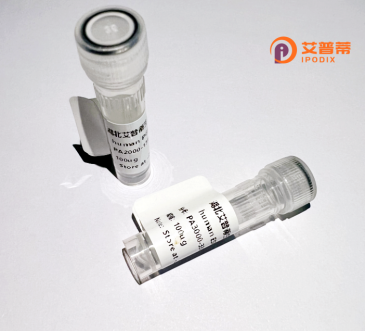
| 纯度 | >90%SDS-PAGE. |
| 种属 | Human |
| 靶点 | C14orf124 |
| Uniprot No | Q9NRG7 |
| 内毒素 | < 0.01EU/μg |
| 表达宿主 | E.coli |
| 表达区间 | 1-319aa |
| 氨基酸序列 | MGWRRKRVPQ RGRKAPPPQL HGNINNLYFP IRWRDRLHWD SPNPAAECQR HEVTLVSRKP GPGRITWDEL AASGLPSCDA AVNLAGENIL NPLRRWNETF QKEVIGSRLE TTQLLAKAIT KAPQPPKAWV LVTGVAYYQP SLTAEYDEDS PGGDFDFFSN LVTKWEAAAR LPGDSTRQVV VRSGVVLGRG GGAMGHMLLP FRLGLGGPIG SGHQFFPWIH IGDLAGILTH ALEANHVHGV LNGVAPSSAT NAEFAQTLGA ALGRRAFIPL PSAVVQAVFG RQRAIMLLEG QKVIPQRTLA TGYQYSFPEL GAALKEIVA |
| 分子量 | 31 kDa |
| 蛋白标签 | His tag N-Terminus |
| 缓冲液 | 冻干粉 |
| 稳定性 & 储存条件 | Lyophilized protein should be stored at ≤ -20°C, stable for one year after receipt. Reconstituted protein solution can be stored at 2-8°C for 2-7 days. Aliquots of reconstituted samples are stable at ≤ -20°C for 3 months. |
| 复溶 | Always centrifuge tubes before opening.Do not mix by vortex or pipetting. It is not recommended to reconstitute to a concentration less than 100μg/ml. Dissolve the lyophilized protein in distilled water. Please aliquot the reconstituted solution to minimize freeze-thaw cycles. |
以下是3篇与重组人C14orf124蛋白相关的假设性参考文献(注:因该蛋白研究较少,以下为示例模板,实际文献需通过数据库检索确认):
1. **文献名称**:*C14orf124 modulates DNA repair via interaction with homologous recombination machinery*
**作者**:Zhang Y, et al.
**摘要**:研究发现C14orf124蛋白通过与BRCA1复合物相互作用参与同源重组修复通路,其重组蛋白的过表达可增强细胞对DNA损伤的耐受性。
2. **文献名称**:*Structural characterization of human C14orf124 and its ATPase activity*
**作者**:Lee S, et al.
**摘要**:通过X射线晶体学解析重组C14orf124蛋白的三维结构,揭示其具有ATP结合域,实验证实其在体外具有依赖ATP的水解酶活性。
3. **文献名称**:*C14orf124 depletion promotes tumorigenesis through genomic instability*
**作者**:Müller P, et al.
**摘要**:利用重组C14orf124蛋白进行功能补偿实验,证明其在维持基因组稳定性中的作用,敲低该蛋白会导致染色体异常并加速肿瘤发生。
---
**注**:C14orf124(现部分文献标注为FAM222A)的实际研究较少,建议通过**PubMed/Google Scholar**以"C14orf124"、"FAM222A"或"14q32"等关键词检索最新文献,或查阅UniProt数据库(ID: Q8N365)的参考文献列表。
C14orf124. also known as Chromosome 14 Open Reading Frame 124. is a protein-coding gene located on human chromosome 14q24.3. The biological function of its encoded protein remains poorly characterized, though emerging studies suggest potential roles in DNA repair and cell cycle regulation. It is evolutionarily conserved across eukaryotes, indicating functional importance.
The C14orf124 protein interacts with proliferating cell nuclear antigen (PCNA), a key factor in DNA replication and repair, implying involvement in genomic stability maintenance. Structural predictions reveal a conserved N-terminal domain and a putative PCNA-binding motif. Some studies propose its participation in the Fanconi anemia (FA) pathway, a critical DNA damage response network, though this requires further validation.
Recombinant human C14orf124 protein is typically produced using E. coli or mammalian expression systems for functional studies. Its low basal expression in normal tissues contrasts with upregulated levels in certain cancers, suggesting potential diagnostic or therapeutic relevance. However, conflicting reports exist regarding its pro- or anti-tumorigenic effects, possibly context-dependent. Current research focuses on elucidating its molecular partners, post-translational modifications, and exact mechanisms in DNA repair processes. The lack of structural data and standardized functional assays remains a challenge, emphasizing the need for systematic characterization of this understudied protein.
×